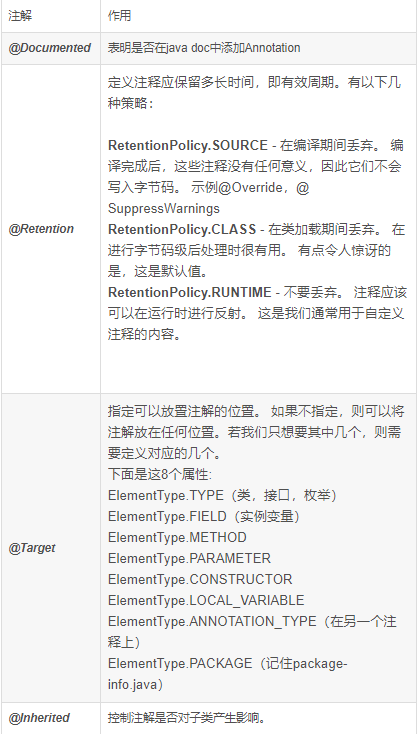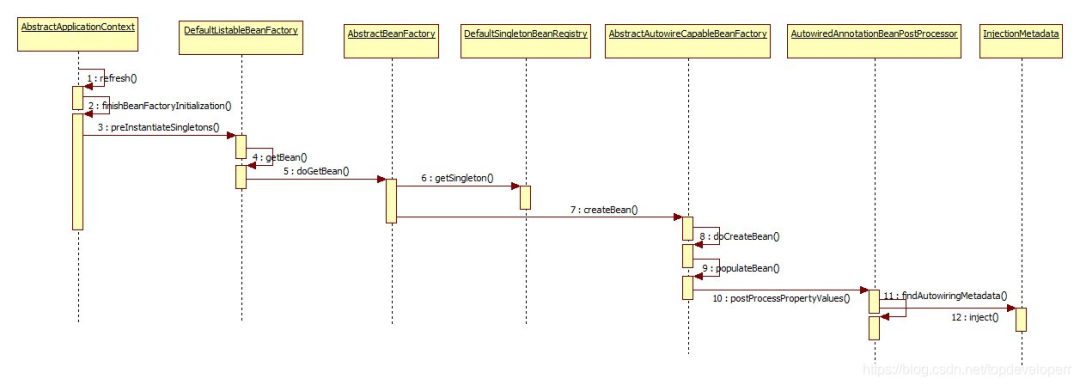@Autowired注解到底怎么实现的,你能说清楚么?
阅读本文大概需要 11 分钟。
来自:blog.csdn.net/topdeveloperr/article/details/87971446
前言
@Autowired注解用法
public class MovieRecommender {
private final CustomerPreferenceDao customerPreferenceDao;
@Autowired
public MovieRecommender(CustomerPreferenceDao customerPreferenceDao) {
this.customerPreferenceDao = customerPreferenceDao;
}
// ...
}
public class SimpleMovieLister {
private MovieFinder movieFinder;
@Autowired
public void setMovieFinder(MovieFinder movieFinder) {
this.movieFinder = movieFinder;
}
// ...
}
public class MovieRecommender {
private MovieCatalog movieCatalog;
private CustomerPreferenceDao customerPreferenceDao;
@Autowired
public void prepare(MovieCatalog movieCatalog,
CustomerPreferenceDao customerPreferenceDao) {
this.movieCatalog = movieCatalog;
this.customerPreferenceDao = customerPreferenceDao;
}
// ...
}
public class MovieRecommender {
private final CustomerPreferenceDao customerPreferenceDao;
@Autowired
private MovieCatalog movieCatalog;
@Autowired
public MovieRecommender(CustomerPreferenceDao customerPreferenceDao) {
this.customerPreferenceDao = customerPreferenceDao;
}
// ...
}
public class MovieRecommender {
@Autowired
private MovieCatalog[] movieCatalogs;
// ...
}
public class MovieRecommender {
private Set<MovieCatalog> movieCatalogs;
@Autowired
public void setMovieCatalogs(Set<MovieCatalog> movieCatalogs) {
this.movieCatalogs = movieCatalogs;
}
// ...
}
public class MovieRecommender {
private Map<String, MovieCatalog> movieCatalogs;
@Autowired
public void setMovieCatalogs(Map<String, MovieCatalog> movieCatalogs) {
this.movieCatalogs = movieCatalogs;
}
// ...
}
@Autowired注解的作用到底是什么
@Autowired注解是如何实现的
例如注解@Override
@Target(ElementType.METHOD)
@Retention(RetentionPolicy.SOURCE)
public @interface Override {
}
自己实现一个注解
java.lang.annotation包中提供了四个注解,仅用于编写注解时使用,他们是:
primitives, string和 enumerations这三种类型。注解的所有属性都定义为方法,也可以提供默认值。我们先实现一个最简单的注解。import java.lang.annotation.ElementType;
import java.lang.annotation.Retention;
import java.lang.annotation.RetentionPolicy;
import java.lang.annotation.Target;
@Target(ElementType.METHOD)
@Retention(RetentionPolicy.RUNTIME)
public @interface SimpleAnnotation {
String value();
}
public class UseAnnotation {
@SimpleAnnotation("testStringValue")
public void testMethod(){
//do something here
}
}
利用反射机制获取一个类的Class对象 通过这个class对象可以去获取他的每一个方法method,或字段Field等等 Method,Field等类提供了类似于getAnnotation的方法来获取这个一个字段的所有注解 拿到注解之后,我们可以判断这个注解是否是我们要实现的注解,如果是则实现注解逻辑
private static void annotationLogic() {
Class useAnnotationClass = UseAnnotation.class;
for(Method method : useAnnotationClass.getMethods()) {
SimpleAnnotation simpleAnnotation = (SimpleAnnotation)method.getAnnotation(SimpleAnnotation.class);
if(simpleAnnotation != null) {
System.out.println(" Method Name : " + method.getName());
System.out.println(" value : " + simpleAnnotation.value());
System.out.println(" --------------------------- ");
}
}
}
@Autowired注解实现逻辑分析
package org.springframework.beans.factory.annotation;
import java.lang.annotation.Documented;
import java.lang.annotation.ElementType;
import java.lang.annotation.Retention;
import java.lang.annotation.RetentionPolicy;
import java.lang.annotation.Target;
@Target({ElementType.CONSTRUCTOR, ElementType.METHOD, ElementType.PARAMETER, ElementType.FIELD, ElementType.ANNOTATION_TYPE})
@Retention(RetentionPolicy.RUNTIME)
@Documented
public @interface Autowired {
boolean required() default true;
}
org.springframework.beans.factory.annotation之中,该包的内容如下:
AutowiredAnnotationBeanPostProcessor之中,已在上图标红。其中的核心处理代码如下:private InjectionMetadata buildAutowiringMetadata(final Class<?> clazz) {
LinkedList<InjectionMetadata.InjectedElement> elements = new LinkedList<>();
Class<?> targetClass = clazz;//需要处理的目标类
do {
final LinkedList<InjectionMetadata.InjectedElement> currElements = new LinkedList<>();
/*通过反射获取该类所有的字段,并遍历每一个字段,并通过方法findAutowiredAnnotation遍历每一个字段的所用注解,并如果用autowired修饰了,则返回auotowired相关属性*/
ReflectionUtils.doWithLocalFields(targetClass, field -> {
AnnotationAttributes ann = findAutowiredAnnotation(field);
if (ann != null) {//校验autowired注解是否用在了static方法上
if (Modifier.isStatic(field.getModifiers())) {
if (logger.isWarnEnabled()) {
logger.warn("Autowired annotation is not supported on static fields: " + field);
}
return;
}//判断是否指定了required
boolean required = determineRequiredStatus(ann);
currElements.add(new AutowiredFieldElement(field, required));
}
});
//和上面一样的逻辑,但是是通过反射处理类的method
ReflectionUtils.doWithLocalMethods(targetClass, method -> {
Method bridgedMethod = BridgeMethodResolver.findBridgedMethod(method);
if (!BridgeMethodResolver.isVisibilityBridgeMethodPair(method, bridgedMethod)) {
return;
}
AnnotationAttributes ann = findAutowiredAnnotation(bridgedMethod);
if (ann != null && method.equals(ClassUtils.getMostSpecificMethod(method, clazz))) {
if (Modifier.isStatic(method.getModifiers())) {
if (logger.isWarnEnabled()) {
logger.warn("Autowired annotation is not supported on static methods: " + method);
}
return;
}
if (method.getParameterCount() == 0) {
if (logger.isWarnEnabled()) {
logger.warn("Autowired annotation should only be used on methods with parameters: " +
method);
}
}
boolean required = determineRequiredStatus(ann);
PropertyDescriptor pd = BeanUtils.findPropertyForMethod(bridgedMethod, clazz);
currElements.add(new AutowiredMethodElement(method, required, pd));
}
});
//用@Autowired修饰的注解可能不止一个,因此都加在currElements这个容器里面,一起处理
elements.addAll(0, currElements);
targetClass = targetClass.getSuperclass();
}
while (targetClass != null && targetClass != Object.class);
return new InjectionMetadata(clazz, elements);
}
public InjectionMetadata(Class<?> targetClass, Collection<InjectedElement> elements) {
this.targetClass = targetClass;
this.injectedElements = elements;
}
@Override
public PropertyValues postProcessPropertyValues(
PropertyValues pvs, PropertyDescriptor[] pds, Object bean, String beanName) throws BeanCreationException {
InjectionMetadata metadata = findAutowiringMetadata(beanName, bean.getClass(), pvs);
try {
metadata.inject(bean, beanName, pvs);
}
catch (BeanCreationException ex) {
throw ex;
}
catch (Throwable ex) {
throw new BeanCreationException(beanName, "Injection of autowired dependencies failed", ex);
}
return pvs;
}
public void inject(Object target, @Nullable String beanName, @Nullable PropertyValues pvs) throws Throwable {
Collection<InjectedElement> checkedElements = this.checkedElements;
Collection<InjectedElement> elementsToIterate =
(checkedElements != null ? checkedElements : this.injectedElements);
if (!elementsToIterate.isEmpty()) {
for (InjectedElement element : elementsToIterate) {
if (logger.isTraceEnabled()) {
logger.trace("Processing injected element of bean '" + beanName + "': " + element);
}
element.inject(target, beanName, pvs);
}
}
}
/**
* Either this or {@link #getResourceToInject} needs to be overridden.
*/
protected void inject(Object target, @Nullable String requestingBeanName, @Nullable PropertyValues pvs)
throws Throwable {
if (this.isField) {
Field field = (Field) this.member;
ReflectionUtils.makeAccessible(field);
field.set(target, getResourceToInject(target, requestingBeanName));
}
else {
if (checkPropertySkipping(pvs)) {
return;
}
try {
Method method = (Method) this.member;
ReflectionUtils.makeAccessible(method);
method.invoke(target, getResourceToInject(target, requestingBeanName));
}
catch (InvocationTargetException ex) {
throw ex.getTargetException();
}
}
}
@Autowired
ObjectTest objectTest;

问题
注解的有效周期是什么?
注入的bean和用它的bean的关系是如何维护的?
为什么注入的bean不能被定义为static的?
推荐阅读:
Spring 和 Spring Boot 最核心的 3 大区别
最近面试BAT,整理一份面试资料《Java面试BATJ通关手册》,覆盖了Java核心技术、JVM、Java并发、SSM、微服务、数据库、数据结构等等。
朕已阅 
评论

